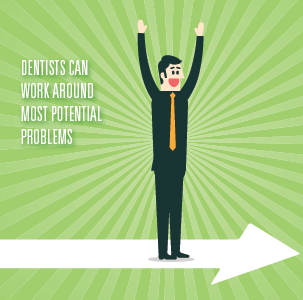
10 Ways to Avoid Pitfalls in Full Mouth Reconstructions.
When attempting a full mouth or full arch reconstruction (FAR), mishaps can happen. To improve as practitioners, dentists should learn to recognize any pitfalls before they occur. This is a critical skill that helps reduce the number of problems associated with each case.
Rather than jumping immediately into a FAR with a patient, doctors must first get all the diagnostic information and form a strategy for putting the patient in the best position for the long-term enjoyment of their teeth. With good diagnostics, dentists can develop a plan of action for preserving a patient’s teeth for functional aesthetics and for support of the temporomandibular joint (TMJ). After years of performing numerous full arch and full mouth reconstructions, I’ve compiled a list of the top 10 pitfalls that dentists may encounter:


1. Not Considering VDO
With FARs, a common pitfall is not determining whether the patient has lost vertical dimension of occlusion (VDO). To help determine VDO, dentists should look at the measurement from the cementoenamel junction (CEJ) on the maxillary central incisors to the CEJ on the mandibular central incisor. This measurement helps dentists to be aware of whether or not an occlusal height problem might exist.
The norm I prefer with this measurement for a class I dentition is 16 to 18 millimeters. If the patient’s measurement is around 14 mm and the doctor begins a restoration, he or she may not have enough clearance to do the appropriate restorative dental work.
The quandary with this particular pitfall is determining how much to open the VDO. Not opening a patient’s vertical enough can exacerbate muscle problems, causing muscle tension and headaches. I advise using panoramic X-rays, a full mouth series of X-rays, or 3D X-rays to determine if the crown-root ratio is favorable or unfavorable.
Choosing an arbitrary number to decide how much to open the bite often leads to problems. For example, a doctor may choose to open a patient’s bite 5 mm without looking at other diagnostic information like root length and stability, and end up creating an unstable crown-root ratio.
The rule of thumb is to maintain, on average, a 2-to-1 ratio, meaning two lengths of the root in the bone to one above. I liken this to building a fence and determining how deep to put the fence posts. If you don’t put them deep enough into the ground and a strong wind hits, they’ll come loose and topple over.
If you put a 10-foot fence post 5 feet into the ground, that’s a one-to-one ratio. But if you take that same fence post and put it 7 feet down into the ground, it will be anchored and solid.
The human jaw is an “anchoring point” for the teeth. If a patient’s teeth have shorter roots, the dentist must be careful about how much to open the vertical. Some doctors open it too much, not knowing that the crown-root ratio can’t handle it, and the result is that the teeth become mobile.
If the crown-root ratio is a one-to-one ratio and the dentist opens up that bite, he or she is going to put undue stress on the individual root complex, and mobility can ensue. In such circumstances, the practitioner may consider splinting teeth together to aid in transferring occlusal pressures.
Another diagnostic issue that doctors may forget to account for is sleep apnea. The Epworth questionnaire is a simple test that can help prevent this pitfall. The test has seven questions about snoring and other sleep issues. A patient who answers yes to a majority of those questions should consult with his or her general practitioner about having a sleep study done.
2. Degree of Tooth Loss
Dentists who pass the hurdle of VDO may run into another pitfall: nonuniform tooth loss throughout the mouth. Every millimeter of tooth loss in the posterior region means a 2 mm collapse in the anterior region, creating the “wedge effect” of the dentition. A simple diagnostic test is to feel for fremitus of the anterior teeth at closure—a tap test in centric occlusion (see explanation in section 3. Entrapment Issues).
One way to test for this is to evaluate the jaw’s range of motion. How wide can the patient open? There are common ranges for males and females—typically 40 mm for females and 50 mm and beyond for males. Anything below such measurements can mean restricted movements, in which case a dentist should not proceed with treatment until it is clear what is causing the restriction. Be sure to address the functional hindrance with orthotic therapy before fast-tracking the restorative phase.
3. Entrapment Issues
Recently, a doctor attempting to do a FAR ran into a pitfall. Once she had the patient in provisional temporaries, the patient started to have jaw joint and muscle problems due to anterior entrapment. This problem does not always become apparent when the patient is in the temporaries, but if it happens, it can lead to muscle instability and result in headaches and joint pain.
The doctor didn’t realize that she had basically locked the patient’s bite with anterior entrapment. Anterior entrapment is defined as a timing and force bite relationship that is not harmonized for the envelope of function, a situation in which the anterior teeth will hit first before the posterior teeth come into contact. This leaves no way for the muscles of mastication to relax.
A simple solution in this case was to relieve the anterior timing occlusion so the back teeth hit first and the front teeth last—in other words, long centric. If the patient’s VDO is 11, the interior teeth can create a deep overbite.
Dentists can avoid this pitfall by testing the patient in diagnostics with the fremitus test. Using his or her finger, the doctor can test for vibration or movement of the anterior teeth as the patient bites into centric occlusion.
To do so, put a finger on the patient’s central incisors and tap. If you feel those teeth touching, moving, or vibrating, it’s a clear indication of entrapment.
Entrapment can and should be verified with a T-Scan™. Every dentist should have a T-Scan™. It is an occlusal analysis system, and it can tell dentists about timing vs. force.
In our dental practice, we do an initial scan, then we go through relaxation techniques with the patient and immediately do another T-Scan™. Using the two different bite scans, we verify that the patient’s bite is different due to issues with occlusal alignment.
Many doctors use occlusal paper to try to guess which tooth hits first based on a dot that’s left on the teeth. They think that the biggest dot is the one that hits first. But dot size does not necessarily equate to intensity. It’s the intensity that matters, and using the T-Scan™ to measure it can be a big paradigm shift for dentists.
To avoid this issue, dentists need to know how to create long centric correction, avoiding anterior entrapment. Prep design is critical in properly pitching the axial inclination of the teeth.
4. Canine Protective Occlusion
Another pitfall deals with establishing canine rise. When patients slide their teeth laterally, they should run up on a canine, which discludes the posterior region (PR). If you can’t see canine rise or enough to quantify it, the patient will once again have issues with clenching, which will lead to headaches and other problems.
Even after insertion visits, there can be a pitfall when a doctor thinks he or she is done and the patient comes back with pain and headaches. The problem might have been introduced by the dentist in the provisionals and then again in the finals. Often doctors are not aware that they possibly caused the problem by not recognizing the lack of canine rise or the interfering posterior teeth, and not discluding in a timely manner.
5. Skipping Gingival Contouring
Unfortunately, doctors do not always take into consideration soft tissue design with FARs. The soft tissue is the framework for the picture, with the teeth being the picture. (For more information on gingival contouring, see my article in the August 2018 issue of Aesthetic Dentistry magazine called “Framing the Picture.”) Particularly in the aesthetic zone, dentists should make the anterior soft tissue look symmetrical left to right.
A front tooth should not be longer or shorter than the one next to it. If corrections can be done on the gingival heights and the zenith points, the doctor should mark it with a red pencil on the model so that the laboratory technician knows what to do when creating a White Wax-Up.
Another potential pitfall in this area is using an electrosurge and/or diode laser for contouring on prep day. Dentists should keep in mind that there must be six to eight weeks of recovery after electrosurgery/diode contouring before they can start prepping for reconstruction. Avoid thinking that all treatment can be done in a day with those modalities. Keep in mind, however, that the DEKA CO2 laser is the best gingival contouring instrument that can be used at the prep appointment with certainty.
Let the lab know if you intend to lean any of the teeth a certain way to create more room in the upper arch so there aren’t any entrapment issues—for example, buccal corridor expansion or anterior axial inclination changes.


6. Not Involving the Team
Continuing education (CE) for dentists is a great opportunity to learn new skills and advance the practice. However, some doctors run into an unnecessary pitfall by not sharing the excitement of what they learned at CE courses with their team members.
After attending a course, dentists should hold team meetings about what they learned and how they would like to implement it. In my practice, we have a weekly team meeting every Monday.
Team members are a big part of the diagnostic process. As the doctor, you rely on them to provide you with the proper information. If you are taking a full set of models on the uppers and lowers, it’s imperative that the team member who does the impressions knows exactly what to capture before moving forward with a case.
Dentists may run into the pitfall of having issues with fit and occlusion if the team members do not capture the key anatomical features. The doctor must inspect what they expect.
I highly recommend using Border-Lock® impression trays to avoid this pitfall. These are semi-custom, moldable trays with no perforations, and are available from Henry Schein. Trays with perforations allow the impression material to ooze out and have the potential to warp and flex.
Dentists want a true hydrostatic press of material into the soft tissue vestibules and around the teeth. It’s essential for capturing the necessary anatomical features. I also suggest using one of two types of impression materials—either AccuDent®, or any polyvinyl siloxane (PVS) impression material.
Be cognizant of the manufacturer’s suggestion of the timeframes that these impressions require in order to eliminate distortions. If pouring stone at the office, make sure to use the proper ratios of powder to liquid to avoid expansion, because little details make a big difference.
Team members should be trained on properly positioning patients in the 3D X-ray units and panoramic units to ensure accurate measurements. Getting proper measurements allows dentists to place implants exactly where they want. If they use a surgical guide, accurate measurements mean that the guide is a correct representation for implant placements.

7. Rushing to Treatment
Fast-tracking a FAR case is a common pitfall. Patients often want the work done as soon as possible, but if the patient has jaw joint issues, headaches, and possibly sleep issues, fast-tracking the case may come back to haunt you.
Test the environment before attempting any restorative procedures so you know that the patient’s comfort level is good, the muscles are comfortable, the jaw joint is stable, and the periodontal tissues are solid.
If you are increasing the VDO on a patient, then you have to take a specific bite registration to put that new VDO into function. Take a muscle-driven bite registration and use splint therapy. I prefer the type of splints that fit on the lower arch. Using an upper splint can again lead to entrapment in the anterior. The most common splints are the Gelb appliance (for deep overbite anterior cases), and the LêDowns appliance (to re-establish canine protrusive disclusion).
The patient needs to be in splint therapy for eight to twelve weeks. With splint therapy, patients undergo a type of physical therapy, retraining their muscles to be at the appropriate resting length. To be effective, the splint needs to be used constantly—not just at night.
One testing modality for figuring out the physiologic rest position of the muscles of mastication involves using something called a TENS unit. If a practitioner doesn’t have that machine, there’s a great mouthpiece called an Aqualizer® that the patient could wear for a few days to relax the muscle. This temporary appliance can be given immediately to the patient.
After the patient wears their orthotic for eight to twelve weeks and is symptom free, the dentist can transfer the new bite registration with the new vertical dimension to have the case remounted at the lab.
I prefer to do the mounting myself to avoid the risk of the upper and lower models being improperly mounted. But some doctors do not have the necessary equipment, such as an articulator.

8. Communicating with the Dental Lab
In terms of communication, it may seem obvious, but always tell the dental lab whether you are doing a full arch or full mouth reconstruction. Let the lab know if the patient is able to have everything done at once or if you need help in segmenting out the case. With a full mouth restoration, always do upper arch reconstructions first.
Without good communication, a big pitfall occurs when the models are not accurately set up at the lab. On maxillary impressions, it’s important to capture the anatomical features such as the hamular-notch incisive papilla (HIP). This allows for hard tissue points of reference and a tripod relationship of the cranial base. Repeatable reference points are critical for lab communication.
Dentists should take a stick bite, giving a reference to a true horizontal behind the patient’s face. Do this with the patient standing up, because the interpupillary line is not level on a majority of patients. Some doctors line their patients up to window blinds and think it is level, but I highly recommend buying a Symmetrigraph. It’s not expensive and ensures better measurements.
When a patient stands against the Symmetrigraph, dentists may notice other structural issues, such as their hips not being level or one shoulder being lower than the other. It may be good to advise the patient to visit a massage therapist, chiropractor, or osteopath to check their skeletal structure so that when you take the bite registration, it can be optimal and support his or her neck and back.
9. Failing to Try In
On prep day, doctors can get so nervous and excited that they may not take time to review the case and try-in certain features that were created to help them prep.
Doctors are often given a bite jig from the lab, and they should try it in and make sure that it fits properly. One pitfall may occur with the insertion of the bite jig. The posterior end on the bite jig can be over-extended and run into the musculature in the corner of the mouth.
Dentists need to recognize that and trim away some of the excess material around that second molar so that the bite jig seats fully. Verify the goal VDO with a Boley gauge and write it on the bite jig.
Doctors may also receive a prep reduction guide from the lab, which helps prevent over- or under-preparation of teeth. This gives doctors a great understanding of exactly where the tooth needs to be prepped.
The last lab piece to try in is the Sil-Tech matrix. This is the matrix formed from the White Wax-Up to fabricate temporary restorations. Try it in to make sure it’s not too bulky and to prevent it from pinching the musculature in the corners of the mouth when the patient opens or closes.
It may need to be thinned out so it seats fully. It shouldn’t wobble when it is placed. The Sil-Tech is indexed to the opposing arch to reduce the pitch, roll, and yaw of the provisionals.

10. Not Being Teachable
One of the most destructive pitfalls is when a doctor develops the attitude that he or she knows everything. Don’t let your ego get in the way. Be open to possibilities. When doctors get dogmatic about a specific approach, they can’t adjust if things go wrong. Every patient is different and if we try to fit a round peg in a square hole, it typically doesn’t work out so well.
Mishaps can happen to anyone. Understanding common pitfalls in full arch and full mouth reconstructions can help dentists learn the most important things to incorporate into their restorative routines.

Don’t let the possibility of a FAR mishap hold you back from moving forward with comprehensive dentistry. With a few thoughtful strategies, dentists can work around most potential problems.









